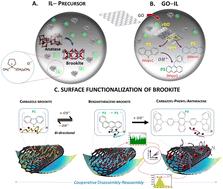Our official English website, www.x-mol.net, welcomes your
feedback! (Note: you will need to create a separate account there.)
Conduction band photonic trapping via band gap reversal of brookite quantum dots using controlled graphitization for tuning a multi-exciton photoswitchable high-performance semiconductor
Nanoscale ( IF 5.8 ) Pub Date : 2024-11-09 , DOI: 10.1039/d4nr03616f Sanjiv Sonkaria, Tae Woo Lee, Aniket Kumar, Soo-Kyung Hwang, Piotr G. Jablonski, Varsha Khare
Nanoscale ( IF 5.8 ) Pub Date : 2024-11-09 , DOI: 10.1039/d4nr03616f Sanjiv Sonkaria, Tae Woo Lee, Aniket Kumar, Soo-Kyung Hwang, Piotr G. Jablonski, Varsha Khare

|
Brookite exists as the metastable phase of titania and often mediates the transformation of anatase to rutile. The photocatalytic competence of brookite relative to polymorphs anatase and rutile has generally been considered structurally and energetically unfavourable for reasons that remain largely unknown and unchallenged. However, the process of phase transformation and performance related cooperativity among all three polymorphs has recently unlocked alternative directions for exploring brookite photovoltaics. Here, we demonstrate the programmable re-configuration of anatase to quantum confined reduced graphene (rGO)–brookite and show it is entirely modulated by surface-driven effects. Key components to this mechanism suggest that the self-assembly of rGO–brookite quantum dots is defect driven through pathways that favour a direct-to-indirect band gap reversal resulting from the graphitization of brookite. The accompaniment of new bandgap characteristics under quantum confinement introduce new hybridized energy states at the graphitic carbon–brookite juncture by modulation of the intrinsic sp2 character to extrinsic sp3 clusters intermediate to graphene quantum dots (GQDs) and graphene oxide quantum dots (GOQDs). Evidenced by the intercalation of photochromic/fluorescent carbazole and anthracene moieties within the rGO framework by self-assembly, we show that the acquired fluorescence and luminescence properties of rGO–brookite are multi-emissive and reversibly quenchable under light excitation and from solvent polarity differences. Further, tuning the excitonic response of rGO–brookite by modulation of the photoluminescence (PL) signal intensity signifies coordinated interaction between localised carbazole and benz(a)anthracene moities which can undergo further structural refinement to adapt more optimally to both internal and external energy waves. Distinguishable by a large red-shift in the photoluminescent emission peak at λ479 nm in the NIR region, we infer that a photoelectron sink driven by the quantum confinement of a narrow band gap of 0.78 eV formed from the orbital overlap of unoccupied interfacial sites promotes strong e−h+ coupling in the hybridized defect structure imposing a high charge separation by hindering e−h+ recombination. Modulation of interlayer spacing between rGO sheets and the synergy of complexation between intercalated carbazole/benz(a)nthracene can be adapted to achieve rapid photodegradation characteristics for DSSC applications.
中文翻译:

使用受控石墨化通过布鲁克石量子点的带隙反转进行导带光子俘获,以调谐多激子可光开关高性能半导体
Brookite 作为二氧化钛的亚稳期存在,通常介导锐钛矿向金红石的转化。相对于多晶型锐钛矿和金红石,Brookite 的光催化能力通常被认为在结构和能量上是不利的,原因在很大程度上仍然未知且未受到挑战。然而,所有三种多晶型物之间的相变过程和性能相关协同性最近为探索 brookite 光伏开辟了替代方向。在这里,我们演示了锐钛矿到量子限制还原石墨烯 (rGO)-brookite 的可编程重新配置,并表明它完全受表面驱动效应的调制。这种机制的关键组成部分表明,rGO-brookite 量子点的自组装是通过有利于 Brookite 石墨化导致的直接到间接带隙反转的途径驱动的缺陷。量子限制下新的带隙特性的伴随,通过将本征 sp2 特性调制到石墨烯量子点 (GQD) 和氧化石墨烯量子点 (GOQD) 中间的外源性 sp3 簇,在石墨碳-布鲁克岩接合处引入新的杂化能态。通过自组装在 rGO 框架内插层光致变色/荧光咔唑和蒽部分证明,我们表明 rGO-brookite 的获得性荧光和发光特性在光激发和溶剂极性差异下是多发射和可逆猝灭的。 此外,通过调节光致发光 (PL) 信号强度来调节 rGO-brookite 的激子响应意味着局部咔唑和苯并(a)蒽基体之间的协调相互作用,它们可以进行进一步的结构细化,以更最佳地适应内部和外部能量波。可以通过 NIR 区域 λ479 nm 处光致发光发射峰的大红移来区分,我们推断,由未占据界面位点的轨道重叠形成的 0.78 eV 窄带隙的量子限制驱动的光电子汇促进了杂化缺陷结构中的强 e-h+ 耦合,通过阻碍 e-h 来施加高电荷分离+ 重组。rGO 片材之间层间距的调制以及插层咔唑/苯并(a)氮草胺之间的络合协同作用可以适应以实现 DSSC 应用的快速光降解特性。
更新日期:2024-11-09
中文翻译:

使用受控石墨化通过布鲁克石量子点的带隙反转进行导带光子俘获,以调谐多激子可光开关高性能半导体
Brookite 作为二氧化钛的亚稳期存在,通常介导锐钛矿向金红石的转化。相对于多晶型锐钛矿和金红石,Brookite 的光催化能力通常被认为在结构和能量上是不利的,原因在很大程度上仍然未知且未受到挑战。然而,所有三种多晶型物之间的相变过程和性能相关协同性最近为探索 brookite 光伏开辟了替代方向。在这里,我们演示了锐钛矿到量子限制还原石墨烯 (rGO)-brookite 的可编程重新配置,并表明它完全受表面驱动效应的调制。这种机制的关键组成部分表明,rGO-brookite 量子点的自组装是通过有利于 Brookite 石墨化导致的直接到间接带隙反转的途径驱动的缺陷。量子限制下新的带隙特性的伴随,通过将本征 sp2 特性调制到石墨烯量子点 (GQD) 和氧化石墨烯量子点 (GOQD) 中间的外源性 sp3 簇,在石墨碳-布鲁克岩接合处引入新的杂化能态。通过自组装在 rGO 框架内插层光致变色/荧光咔唑和蒽部分证明,我们表明 rGO-brookite 的获得性荧光和发光特性在光激发和溶剂极性差异下是多发射和可逆猝灭的。 此外,通过调节光致发光 (PL) 信号强度来调节 rGO-brookite 的激子响应意味着局部咔唑和苯并(a)蒽基体之间的协调相互作用,它们可以进行进一步的结构细化,以更最佳地适应内部和外部能量波。可以通过 NIR 区域 λ479 nm 处光致发光发射峰的大红移来区分,我们推断,由未占据界面位点的轨道重叠形成的 0.78 eV 窄带隙的量子限制驱动的光电子汇促进了杂化缺陷结构中的强 e-h+ 耦合,通过阻碍 e-h 来施加高电荷分离+ 重组。rGO 片材之间层间距的调制以及插层咔唑/苯并(a)氮草胺之间的络合协同作用可以适应以实现 DSSC 应用的快速光降解特性。

































 京公网安备 11010802027423号
京公网安备 11010802027423号